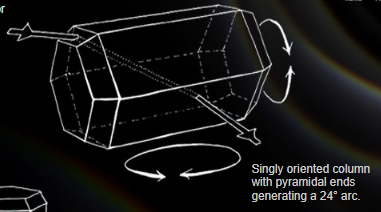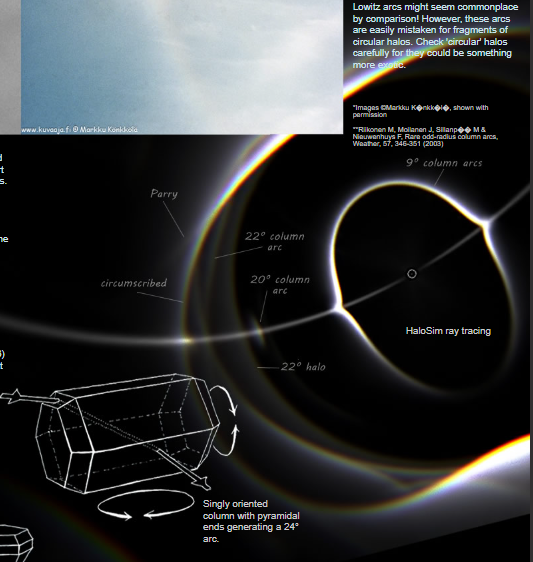OPOD - 1985 Finland 24 degree column arcs
OPOD - 1985 Finland 24 Degree Column Arcs: A Rare Atmospheric Phenomenon
In July 1985, Markku Könkkölä captured a remarkable atmospheric optical phenomenon known as the 24° column arc in Utsjoki, Finland, near the Teno River. This rare arc, only the second known image of its kind, is nestled between the bright circumscribed halo and a fainter inner 22° circular halo. The original film image, processed using a color subtraction technique by Nicolas Rossetto, enhances the colored halos, providing a visually stunning representation of this captivating atmospheric event.
The 24° column arc belongs to a family of "Odd-radius column arcs" produced by oriented pyramidal crystals. Unlike common pyramidal crystals that have short central hexagonal prism sections and random orientations, long hexagonal columns with pyramidal ends can assume precise orientations. These crystals have their long axis predominantly horizontal, often accurate to within a degree, while freely rotating about the axis. Although individual crystals do not spin, the collective arrangement of millions of crystals creates the mesmerizing "column arcs" observed in the sky.
The formation of the 24° column arc captured in the image is attributed to rays entering a pyramidal face and exiting through an ordinary prism side facet. This particular ray path, known as path 15,3, generates the distinct 24° arc visible in the photograph. Conversely, the reverse path produces an equivalent arc primarily below the parhelic circle. Other ray paths give rise to additional column arcs, such as the 20° and 9° arcs. The 20° rays (path 13,16) pass through two pyramidal faces and may result in faint halos if the faces are small. The 9° column arc (path 13,6) lies outside the camera's field of view, making its visibility uncertain.
Pyramidal crystals, from an aerodynamic perspective, typically exhibit rounded shapes and can tumble and tilt in various directions. However, a small subset of these crystals assumes plate-like orientations, resulting in pyramidal plate arcs, another fascinating atmospheric optical phenomenon. These plate-like crystals generate distinct patterns in the sky, adding to the complexity and beauty of atmospheric optics.
The 24° column arc observed in Finland in 1985 is a testament to the intricate and captivating nature of atmospheric optics. While lowitz arcs may seem more commonplace in comparison, it is important to carefully examine circular halos as they may conceal more exotic phenomena like odd-radius column arcs. This rare occurrence serves as a reminder of the endless wonders that await our exploration and understanding in the realm of atmospheric optics.
Please note that this article has been automatically converted from the old site and may not appear as intended. For the original article, you can visit the link provided.

24° Column Arc, Finland
Markku K�nkk�l� (photography, blog) imaged this very rare arc in July 1985 at Utsjoki by the Teno River in Finland.
At right is the original film image, at left it is processed by a colour subtraction technique of Nicolas Rossetto that enhances coloured halos. The sun was 42.5� high and the rare arc nestles between the bright circumscribed halo and a the much fainter inner 22� circular halo.
This is only the second known image of the arc. The first was by Frank Nieuwenhuys at The Hague, Netherlands in 1973... It was recently imaged by Radek Grochowski in Poland.
Lowitz arcs might seem commonplace by comparison! However, these arcs are easily mistaken for fragments of circular halos. Check 'circular' halos carefully for they could be something more exotic.
.Images ©Markku K�nkk�l�, shown with permission
..Riikonen M, Moilanen J, Sillanp�� M & Nieuwenhuys F, Rare odd-radius column arcs, Weather, 57, 346-351 (2003)
The halo belongs to a family of �Odd-radius column arcs� produced by oriented pyramidal crystals. Common pyramidal crystals have short central hexagonal prism sections and tend to take random orientations. We then see a series of circular �odd-radius� halos.
Long hexagonal columns with pyramidal ends can, in contrast, take precise orientations. The long axis is horizontal, often to better than a degree, while the crystal is free to take any rotational position about the axis. An individual crystal does not necessarily �spin�. Instead, millions of crystals happen to have all rotational positions to produce �column arcs�.
The 24° column arc of the image was produced by rays entering a pyramidal face and leaving through an ordinary prism side facet (path 15,3). The reverse path gives an equivalent arc mainly beneath the parhelic circle.
Other ray paths generate 20°and 9° column arcs. The 20° rays (13,16) pass through two pyramidal faces which, if small, would give only faint halos. The 9° column arc (13,6) is out of the camera field and may or may not have been visible.

Singly oriented column with pyramidal ends generating a 24° arc.

Pyramidal crystals are mostly rather rounded from an aerodynamic viewpoint. They tumble and tilt in all directions
A few take up plate-like orientations to generate pyramidal plate arcs.

Note: this article has been automatically converted from the old site and may not appear as intended. You can find the original article here.
Reference Atmospheric Optics
If you use any of the definitions, information, or data presented on Atmospheric Optics, please copy the link or reference below to properly credit us as the reference source. Thank you!
-
<a href="https://atoptics.co.uk/blog/opod-1985-finland-24-degree-column-arcs/">OPOD - 1985 Finland 24 degree column arcs</a>
-
"OPOD - 1985 Finland 24 degree column arcs". Atmospheric Optics. Accessed on November 22, 2024. https://atoptics.co.uk/blog/opod-1985-finland-24-degree-column-arcs/.
-
"OPOD - 1985 Finland 24 degree column arcs". Atmospheric Optics, https://atoptics.co.uk/blog/opod-1985-finland-24-degree-column-arcs/. Accessed 22 November, 2024
-
OPOD - 1985 Finland 24 degree column arcs. Atmospheric Optics. Retrieved from https://atoptics.co.uk/blog/opod-1985-finland-24-degree-column-arcs/.